Tested Technology is proactive on your behalf. We go out into the consumer marketplace actively seeking devices (mostly, software sometimes) that are going to be of interest to you.
Occasionally, manufacturers seek us out. This has started to happen more often, now that the publication is gaining momentum. But we’re not a manufacturer’s showcase and our time is yours, not theirs.
However, when the Chinese manufacturer, Meross, contacted us we paid attention. They make good smart plugs. We’ve had half a dozen of these around Tested Technology Towers for over a year now. They switch lights on and off for us when we’re away. We’ve used them for energy monitoring electrical devices. One of them is in permanent charge of our hot water immersion heater. They’ve proved to be reliable and they’re cheap.
So when we got their email we said, yes. Happy to take a look at their latest product.
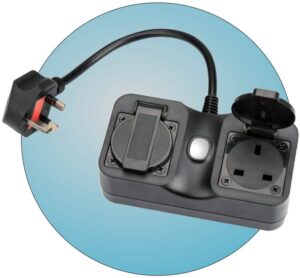 THE MEROSS DUAL OUTDOOR SMART PLUG is a reassuringly rugged mains power component rated at 2KW and designed for outdoor use. Its pair of plugs can be independently WiFi-controlled (in the 2.4GHz band) and harnessed to Google’s Home control system, Amazon Alexa or Apple’s HomeKit.
THE MEROSS DUAL OUTDOOR SMART PLUG is a reassuringly rugged mains power component rated at 2KW and designed for outdoor use. Its pair of plugs can be independently WiFi-controlled (in the 2.4GHz band) and harnessed to Google’s Home control system, Amazon Alexa or Apple’s HomeKit.
Executive summary: this double smart plug is a bargain you can pick up for around £13 per socket.
But what would you use it for?
The first “4” tells us it offers protection against solid objects larger than 1mm—wires, screws, large insects. The second “4” defines the moisture part of the standard and suggests you can splash water onto it from all directions for at least ten minutes without any harmful effects.
But the official IP moisture rating maxes out at 9, so we’re not even halfway to the full protection against “high pressure, high temperature jets sprays”. Not that you’d need that out in the garden. But any electrical equipment permanently installed out there would at least need IPx5 (low pressure jets from all angles) in case of rain. And probably even IPx6 (very heavy rain).
And the short (27cm) lead means you’d either need a waterproof mains sockets already installed in the garden area or a waterproof extension cable. These seem to be designed to the IPx5 standard and a 15 meter extension cable will cost you another £25 or so.
In the dim light of the extraordinarily dismal summer we’re currently not enjoying I decided to forego any lengthy outdoor testing. Evidently, the Meross Dual Outdoor Smart Plug is something you’ll have to treat as a fairweather friend and make sure to bring it back into the house once the barbeque guests have departed.
Hi, Google, Alexa and Siri
But there’s plenty that you can do with this thing indoors. We’re set up here to check out the Alexa connection as well as Google Home Assistant. The challenge is Apple’s HomeKit, which Meross has gone out of its way to accommodate.
I’ve been a Mac fan and heavy Mac user since the mid-80s (and, more particularly since 2001, when Apple launched into its MacOS phase after adopting the NeXTStep operating system—but that’s another story for another time). The iPhone, though, and the now deeply entrenched iOS/MacOS ecosystem, is a Grimpen Mire I’ve been careful to skirt around for the past decade or so. Which puts HomeKit is out-of-scope for Tested Technology.
Apple’s HomeKit is a software framework that can be used as a basis of firmware design by manufacturers who sign up to Apple’s MFi program. By using it, Meross has ensured compatibility with Apple devices—although, happily, not exclusively. This means that the Meross Dual Smart Plug, along with a whole range of third party manufactured devices from air conditioners to windows (the physical kind, not, obviously, the operating system) can be controlled from your iPhone* and Siri.
You might argue that it’s unfair to call HomeKit a “walled garden” as portions of the software were made open source at the end of last year. Here Apple was falling into line with Google and Amazon, whose comparable home automation schemes have been proving far more successful in the marketplace. But all three approaches to home automation depend on manufacturers signing up to proprietary programs. Opening up accessibility to devices that have joined these clubs is clearly a sensible marketing ploy to encourage wide adoption.
A Digression on Standards
Currently, the home automation market is very much in the same position as the personal computer market back in the early ’80s, when we were still calling computers “micros”. So many different standards. There was a running joke at the time, attributed to the Andrew S. Tanenbaum:
The nice thing about standards is that there are so many of them to choose from.
Back in 1984 the IT journalist Ben Woolley and I wrote a book called “The Micro Enquirer” to introduce readers to this exciting new world of affordable home computing.
I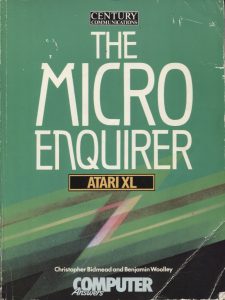 say “a book”—it was actually four different books tailored for the Atari XL, the BBC Micro, the Sinclair Spectrum and the Commodore 64. And those were only the four our publisher judged most popular. There were dozens of different proprietary microcomputer brands. And if you bought, say, a Commodore 64, you would have been shut out from the world of any of the others.
say “a book”—it was actually four different books tailored for the Atari XL, the BBC Micro, the Sinclair Spectrum and the Commodore 64. And those were only the four our publisher judged most popular. There were dozens of different proprietary microcomputer brands. And if you bought, say, a Commodore 64, you would have been shut out from the world of any of the others.
Something along these lines seems to have happened to home automation. This workaround from Meross makes the best of it by including all three proprietary protocols. The price to pay for this from Meross’s point of view is the cost of three separate licences.
(And in the case of HomeKit, manufacturers have to pay a developer’s licence, a manufacturer’s licence as well as the price of incorporating an Apple-exclusive security chip in each one of the devices they sell.)
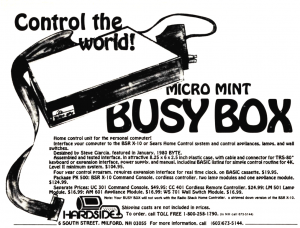
If you’re thinking Home Automation is a new technology here’s an advert from a 1980 Byte Magazine to change your mind.
Some of this will be passed on to you, the customer, although Meross seems to have been able to keep the cost well down.
But there’s another more important cost. Accommodating three quite different protocols seems to have squeezed out an important and useful feature of the Meross standard smart plugs we’ve had here for a year or so. These respond to Alexa and Google’s own protocol but know nothing of Apple’s HomeKit. There is room in their flash memory, however, for power consumption measurement. The Meross Android app will report to us, for example, how many kilowatt-hours the immersion heater has used in the past week or month.
The Meross Dual Outdoor Smart Plug has no power consumption measurement.
So Many to Choose From
But there’s some possible good news on the horizon.The logical conclusion of this approach would be to unite the proprietary software frameworks developed by Apple, Google and Amazon (and others) into a single unifying standard. And that now appears to be happening.
The CHIP project (Connected Home Over IP**) was formed at the end of last year by a consortium of players. The initiative came from ZigBee, the low-profile pioneer of Internet of Things (IoT) connectivity. ZigBee seems to have managed to bash Apple, Google and Amazon’s heads together to set them on the path to a common protocol designed to end up with everything working with everything.
And this won’t so much be yet another standard—it’s destined to be an intelligent merging of the best of the existing proprietary protocols riding on top of the oldest and best established protocol of them all: IP. If you want to delve into this further, this excellent article from Forbes is worth reading.
Checking Out the Smart Plug’s Smarts
But that’s for the future. Back to the Meross Dual Smart Plug in the here and now.
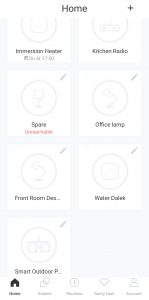
A plug icon will turn blue when it’s switched on.
Meross offers its own free-of-charge smartphone app. We tested this using the Android version. You’ll need this app, on Android or iOS, to set up the plug’s wireless connection.
The initial installation works the same way as most wireless connected devices. The plug powers up when connected into the mains and creates its own wireless access point (AP), transmitting to advertise its presence. The app picks this up and temporarily switches your phone’s wireless connection to this new AP.
Your phone will now be disconnected from the Internet but communing with the plug. With your permission, the password to your wireless network is then transferred to the plug and your phone reverts to its original wireless setting, connecting again with the Internet. The plug signs itself into your wireless network and becomes a member of your LAN with its own IP address.
It appears in your app as shown in the picture. Tapping any of the other reachable smart plugs will turn them on or off. If you tap the Outdoor smart plug you get transferred to a new app page.
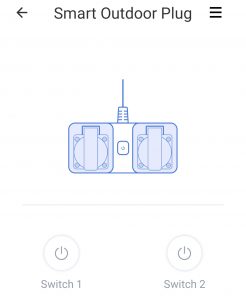 Here the two plugs are shown separately.
Here the two plugs are shown separately.
This shows the two separate plugs, allowing you to control either of them individually. By default they’re just called Switch 1 and Switch 2 but for easier reference you can rename them according to whatever they’re controlling.
Once that’s done, if you’re using Google Home or Amazon Alexa, these smartphone apps will automatically pick up on the Meross settings. You can now say, Alexa, switch my Anglepoise on or Hey, Google, switch my reading light off.
If you’re using iOS, there’s an extra security step, involving scanning the unique HomeKit QR code on the back of the Dual Smart Plug. The full process is nicely explained in this YouTube video from HomeKit Authority.
But How Smart is a Smart Home?
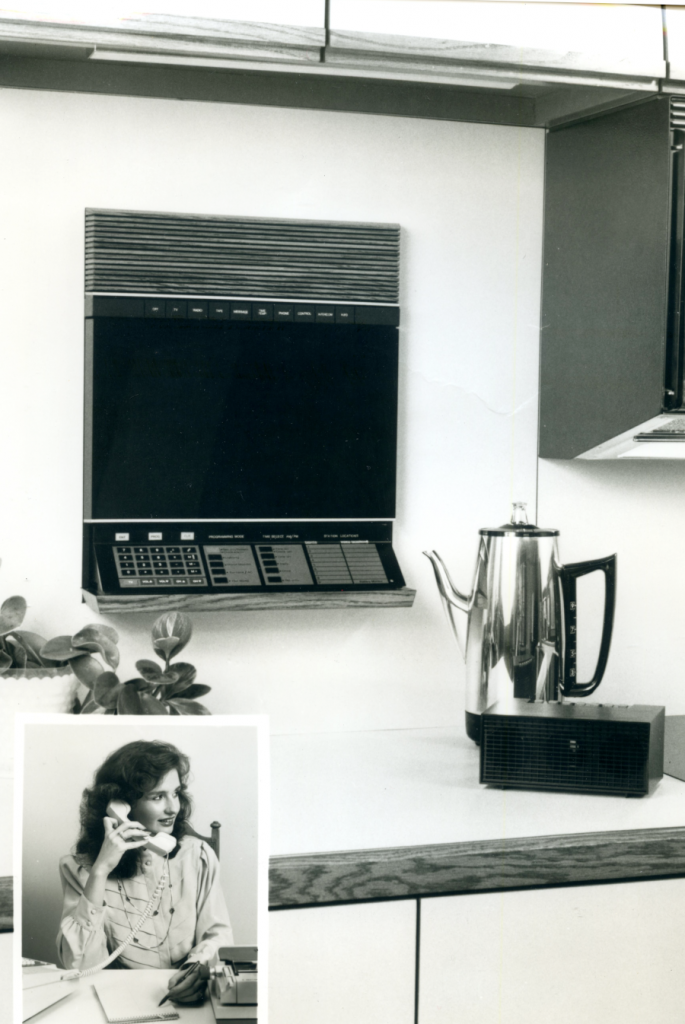
 (Photo from CES, 1983, with thanks to Tekkiepix.)
(Photo from CES, 1983, with thanks to Tekkiepix.)
The Smart Home idea has been around for a very long while. WiFi, the Internet and the low cost of mass-produced components have now opened the concept up to everybody.
Yes, but if you’re able-bodied, isn’t it still a lot easier to flip a switch physically to turn on the light rather than find your phone, unlock it, open the relevant app and press the virtual button?
This may be why all these three main approaches to home automation allow you to incorporate individual smart device controls into Scenes. Instead of turning an individual device on or off, when you drive a scene with voice control you can arrange for a whole set of events to happen.
Once your Dual Outdoor Smart Plug has been christened and tied into your LAN it can join one of these multiple smart device scenarios. And then you can instruct Siri or Google or Amazon, for example, to “Start the Cinema”.
This single command could close the curtains, switch off the lights, switch on the AV receiver, start up your projector and maybe even extend your electrical recliner into your favourite viewing position.
Of course, a smart plug like the one under review can only switch things on or off. You might want just to dim the lights in your Cinema scenario. It can’t do that. And although it would useful for turning on your projector, a projector is one of a number of IT devices (your computer is another) that should never be switched off just by cutting the juice. The built in button or remote control action for closing down a projector switches off the lamp but allows the fan to run for a while so it can cool down in an orderly fashion.
 Tested Technology technical advisor Marcus Mazure started using Amazon Alexa to turn his bedroom lights on and off. “It was fun at first,” he says, “but the WiFi occasionally fails and you end up having to fiddle about with your router when you should be having breakfast”. A physical light switch is something you can expect to go on working for generations. Voice-controlled WiFi, not so much.
Tested Technology technical advisor Marcus Mazure started using Amazon Alexa to turn his bedroom lights on and off. “It was fun at first,” he says, “but the WiFi occasionally fails and you end up having to fiddle about with your router when you should be having breakfast”. A physical light switch is something you can expect to go on working for generations. Voice-controlled WiFi, not so much.

Contributor Barry Fox has been through the same sort of experience. “It’s a bit nutty to be talking to your devices when it’s usually simpler just to press a button”. The one context where he sees voice activation as being genuinely useful is in the car. “You don’t want to have to take your eyes off the road just to change radio stations,” he says.
Routines
As well as being ganged up with other smart devices into Scenes, the Meross Dual Smart Plug can also be assigned one or more Routines. This turns each of the two plugs into timer devices. A single routine will power a switch according to a schedule. Oddly, you’ll need to set up a separate routine to switch it off again. Alternatively, a routine can power a switch for a particular duration.
The plugs know where you are in the world (because you have to sign into the Meross system to make any of this work*) and this makes them smart enough that you can substitute “Sunrise” and “Sunset” for specific times.
A Plug for All Seasons?
Probably not. I’d be uncomfortable with leaving this device outside in British weather unless I could be positive it was unpowered. For limited use outside and for all kinds of tasks inside, this rugged double socket certainly has enough smarts to justify its modest price of around £25.
Chris Bidmead
